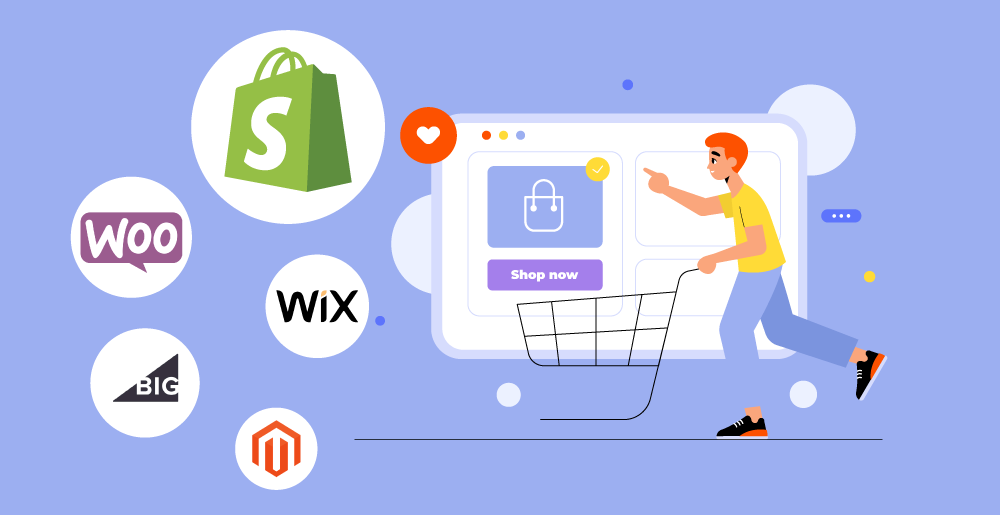In the rapidly evolving world of online commerce, brands confront a formidable challenge: standing out in an increasingly crowded marketplace. With a staggering 9.5 million eCommerce websites in the United States alone, contributing to a significant 36.3% of the global eCommerce market, establishing a unique identity has become non-negotiable for the triumph of any eCommerce venture.
Amid this competitive landscape, brands navigate a plethora of avenues to express their distinct personality. From crafting engaging social media campaigns to curating compelling content, marketers devote relentless efforts to connect with their target audience.
A well-designed website can be the difference between a fleeting visitor and a loyal paying customer, a mere transaction and a lasting connection. This article delves into the intricacies of eCommerce website design and its pivotal role in shaping brand perception, user experience, and ultimately, business success.
Achieving ecommerce success hinges on a thorough understanding and application of key performance indicators (KPIs) that fuel outstanding customer experiences. Delving into the realm of User Experience (UX), certain KPIs offer profound insights into consumer satisfaction and engagement levels. These metrics serve not only as benchmarks for assessing current performance but also guide strategic enhancements aimed at elevating the overall ecommerce journey.
What Are Your Options for E-commerce Platforms?

When it comes to building your online e-commerce store, there are a lot of options. The first platform that comes to mind is not other than WordPress. Or, if you want a creative, fully customized, and faster store, you can opt for solutions like Shopify, Magento, BigCommerce, etc. Each platform has its pros and cons, and the choice should align with your business needs, goals, and resources.
While WordPress provides you with easy-to-go templates to set up your store in a few minutes, other platforms can be a little challenging and hard to maintain. Though custom e-commerce CMS such as Magento or BigCommerce provides a huge range of advanced features and super-smooth customer experience, their overall store cost increases as well.
Why You Should Choose WordPress?
WordPress is known for its user-friendly content management system. WordPress is quite popular for building websites of all kinds, including e-commerce platforms. It offers a range of e-commerce plugins, with WooCommerce being the most prominent.
Pros of Using WordPress for E-commerce
- Ease of Use: WordPress is famous for its user-friendly and easy-to-use interface. It’s an ideal choice for beginners looking for a low-cost, yet easy-to-use CMS for their e-commerce store.
- Customization: With a wide array of themes and plugins available, you can tailor your e-commerce store that better meet your store’s unique identity and functionality requirements.
- Cost-Effective: WordPress itself is open-source and free to use. Many of its plugins are also affordable or come with free versions – enough to begin with.
Cons of Using WordPress for E-commerce
- Scalability: While suitable for small to medium-sized businesses, WordPress may face limitations when handling high-traffic and complex e-commerce operations.
- Maintenance: Regular updates are required to ensure your WordPress e-commerce store’s security and performance. This can be time-consuming for users with limited technical expertise.
- Security: WordPress sites can be vulnerable to security threats, which makes robust security measures crucial.
However, it doesn’t mean that WordPress is a low-quality platform for e-commerce stores. You can also build a fully custom e-commerce store on WordPress or customize your theme that match your store’s needs. Even if you don’t have extensive knowledge or expertise in docking or development, you can hire a professional development company to assist you in customizing your store.
With a development company, you can have a store that is easy to maintain in the backend, thanks to WordPress CMS, fully customized, creative, and offers all the advanced features to your visitors on the storefront. Doing this all by yourself, can be quite hard and might result in a website crash if you accidentally delete or change some crucial files. So, it’s highly recommended to work with a professional development team or company if you want a customer-centric, unique, and advanced e-commerce store.
Why Should You Opt for Custom E-commerce Platforms
Custom e-commerce solutions such as Shopify, Magento, and BigCommerce, offer dedicated platforms designed explicitly for online retail. These solutions provide a comprehensive suite of e-commerce features right out of the box.
Beginning your e-commerce journey with these platforms offers you a wide range of features and access to tools that allow you to 10x your journey right from the start. And you don’t have to hire a WordPress development company for this.
Pros of Custom E-commerce Solutions
- Specialization: Custom e-commerce platforms are tailored for online retail, offering advanced features, scalability, and reliability.
- Scalability: They are well-equipped to handle high traffic and support extensive product catalogs, making them suitable for businesses with aggressive growth plans.
- Security: Custom e-commerce solutions often come with built-in security features that reduce the risk of hacking, data breaches, and cyberattacks.
Cons of Custom E-commerce Solutions
- Cost: Custom solutions often come with a price tag. There may be monthly subscription fees, transaction charges, and costs associated with advanced customization.
- Learning Curve: These platforms may have steeper learning curves, requiring more time and effort to set up and manage effectively.
- Not Much Flexibility: While they offer extensive advanced e-commerce features, these solutions might not be as flexible or customizable as WordPress.
When it comes down to it, your online store’s success is all about how your customers feel when they visit. You gotta make sure your website looks good and is easy to use. Your website is like your shop’s main hangout spot, where your visitors come to get to know your business, the people behind it, and what you’re selling. Since customers will be spending time here, you don’t want to drop the ball on their experience. If your website is confusing or not fun to use, people might lose interest and not buy anything.
Several studies show that a whopping 75% of shoppers judge a business based on how its website looks. So, having a slick, pro-looking website can make folks see you as a legit brand and trust you more. Plus, in today’s world, people are all about visuals, so nailing that website design can help you reach a bigger audience.
Bonus Tip for Unique Ecommerce Design Tips for Better Customer Experience
If you have some or a little experience in the web design industry, you must have heard of a website design approach, PSD to WordPress conversion. It’s highly recommended if you’re looking for a completely unique, flexible, and customer-centric design for your website.
In this process, you get your website design files ready in PSD (Photoshop Document) and then convert these design files into a responsive and functional WordPress theme. Now, this might sound time-consuming and a lot more expensive than just proceeding with a pre-made WordPress theme. But, that theme is being used by thousands of other businesses online, even though it’s paid, and that leaves your website with a sort of duplicate design.
In most cases, PSD to WordPress conversion costs less than custom e-commerce solutions or WordPress themes. In addition to that, opting for PSD to WordPress conversion gives you the freedom to add anything; features, animation, widgets, forms, you name it, without worrying about disturbing the theme coding – which often happens in customizing pre-made WordPress themes. In short, PSD to WordPress conversion is the ideal, creative, affordable, and responsive web design approach, if your goal is to have a unique customer experience.
So, without further ado, let’s proceed with our top ecommerce design tips.
1. Create a Strong First Impression
The aesthetics of an eCommerce website play a pivotal role in forming the initial impression on visitors. Research shows that it takes a mere 0.05 seconds for users to form an opinion about a website, demonstrating the swiftness with which the first impression is cast. A visually pleasing website, mixed with a user-friendly interface can immediately hook your visitors and convince them to explore further.
Essential design elements, such as color schemes, typography, and visual layout, contribute to the overall ambiance of the website. Aligning these elements with the brand’s identity enhances its coherence and fosters a sense of familiarity. A visually harmonious and inviting website communicates professionalism and authenticity, setting the stage for a positive user experience.
2. Optimize Your Store for Mobile Devices

Is your online store looking all snazzy on a computer but dragging its feet on mobile devices? Well, here’s the scoop: to give your e-commerce customers the best experience, you’ve gotta make sure your site plays nice with mobiles.
A 2021 report revealed that mobile e-commerce sales in the US hit a whopping 360 billion U.S. dollars. And guess what? They predict that by 2025, that number’s gonna double to a jaw-dropping 710 billion U.S. dollars.
To break it down for you, if your e-commerce store isn’t mobile-friendly yet, you could be waving goodbye to millions of potential customers. If your store takes forever to load on a mobile, people might just hop over to your competitors. To fasten up things, you’ll have to cut some stuff down, like fields or buttons.
But here’s the kicker – make sure all your pages, product images, and descriptions fit nicely on a smartphone screen. If you’re using WordPress, pick a theme or use plugins that work flawlessly on mobile devices. Your customers will love it!
3. Easy Navigation and Accessibility

In the digital realm, user attention is a precious commodity. A well-designed eCommerce website prioritizes navigational ease, ensuring your visitors find what they seek. Intuitive navigation menus, strategically positioned calls-to-action, and clear pathways facilitate seamless exploration. The goal is to eliminate friction in the user journey, enabling effortless access to products, services, and vital information.
A seamless browsing experience extends beyond desktop devices to encompass mobile responsiveness. As more and more people are visiting websites through their mobile devices, having a mobile-friendly design is non-negotiable. A responsive design works flawlessly on all screen sizes, guaranteeing a consistent experience across devices.
4. Use Visual Storytelling and High-Quality Images
Humans are inherently drawn to visuals, making imagery a potent storytelling tool for eCommerce websites. High-quality images showcasing products from different angles, detailed close-ups, and lifestyle shots can effectively communicate the essence and benefits of each offer Visual storytelling not only aids in product understanding but also evokes emotions, fostering a deeper connection between the brand and the consumer.
Moreover, visual elements can significantly impact search engine optimization (SEO). Optimized images with descriptive alt text enhance the website’s accessibility and search engine visibility, contributing to higher rankings in SERPs.
5. Provide a Customer-Centric User Experience

Central to the philosophy of eCommerce website design is a customer-centric approach. Every aspect of the design should facilitate a smooth, intuitive, and enjoyable experience for the user. The checkout process, for instance, should be streamlined and user-friendly, minimizing steps and eliminating unnecessary hurdles. Studies reveal that a frictionless checkout experience can substantially reduce cart abandonment rates and boost conversions.
Incorporating personalized elements further enhances the user experience. Recommendations based on purchase and browsing can guide users toward products aligned with their preferences. Interactive features, such as product configurators or virtual try-ons, provide users with a sense of engagement and empowerment.
6. Build Trust and Credibility
A well-designed eCommerce website can effectively cultivate trust, a cornerstone of online transactions. Elements such as secure payment gateways, visible contact information, and customer reviews contribute to the credibility of the website. A dedicated “About Us” section offering insights into the brand’s history, values, and mission fosters transparency and establishes an emotional connection with visitors.
Additionally, a professional design exudes a sense of authority and expertise. People are more likely to trust a website that appears engaging, efficient, user-friendly, and one that aligns with your industry’s standards.
Conclusion
How you style your e-commerce store is a big deal – it’s like the first impression you make on your regulars and folks checking you out for the first time. So, don’t shortchange it! Put in the time and effort, just like you would with any marketing strategy, to make sure your visitors have a great time shopping with you.
If your goal is building a brand out of your e-commerce store, don’t hesitate to invest your time, energy, and resources into it. If you’re thinking about hiring a development company for a seamless customer experience, do it. If you have to buy subscriptions of plugins and tools for a better customer experience, do it.
When you nail that design and give shoppers what they expect, they’ll keep coming back for more. So, here’s to a well-designed user interface that keeps the good vibes going. We’re here to hook you up with some cool ecommerce design tips that’ll keep you on top, no matter what changes come your way.




